DERELICTION OF DUTIES by
American Leaders and the
Sacrifice of Bataan
I'm still wondering if anyone can tell me what threat Germany was to the U.S. in 1941-42? Why "Europe First"??? Could it have been to help out Stalins regime at the expense of American lives? I just don't see the need for Europe first being in the U.S. strategic intrest at that time. I'd be happy if someone could explain to me how it was strategically better FOR THE USA to be involved in a European war when we were first attacked in the Pacific. |

A big coastal gun is fired from fortified American positions on Corregidor Island, at the entrance to Manila Bay on the Philippines, on May 6, 1942. (AP Photo) # 
Corregidor on the horizon. Between December 24, 1941 and February 19, 1942, Corregidor became the temporary location for the Government of the Philippines. On December 30, 1941, outside the Malinta Tunnel, Manuel L. Quezon and Sergio Osmeña were inaugurated respectively as President and Vice-President of the Philippines Commonwealth for a second term.

The Tail of Corregidor Island with Hooker's Point at the farthest end
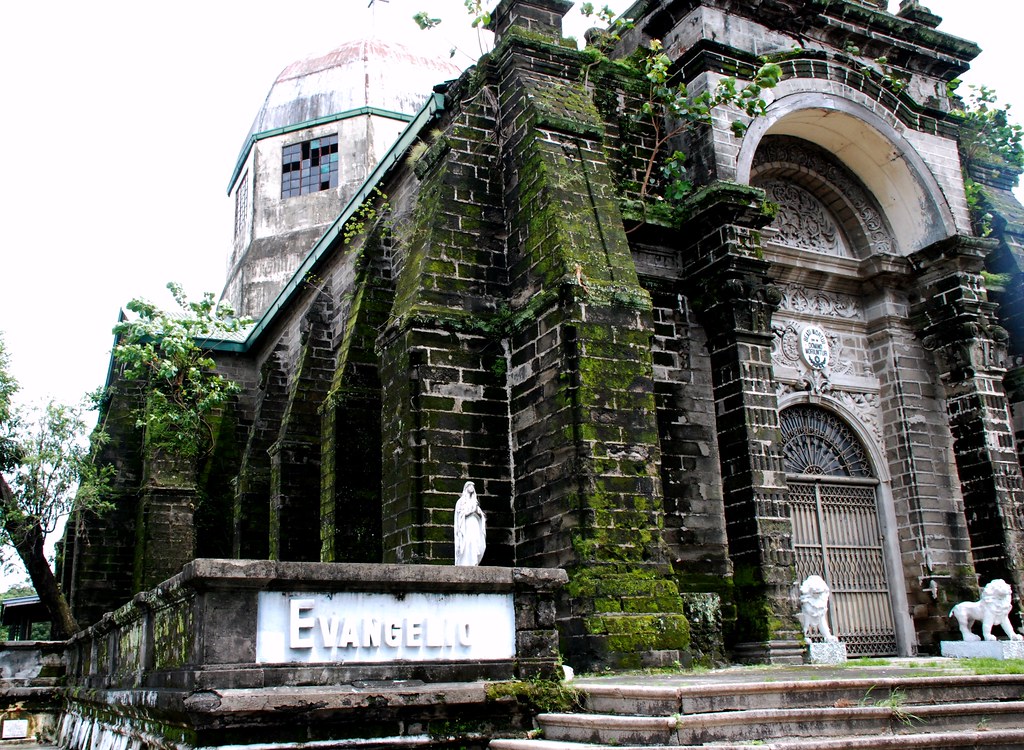 Church at the Campo Santo de La Loma. Today it is All Saints' Day. Filipinos observe this day by visiting their dead relatives in cemeteries and memorial parks and columbariums, go to church and light candles in commemoration of this day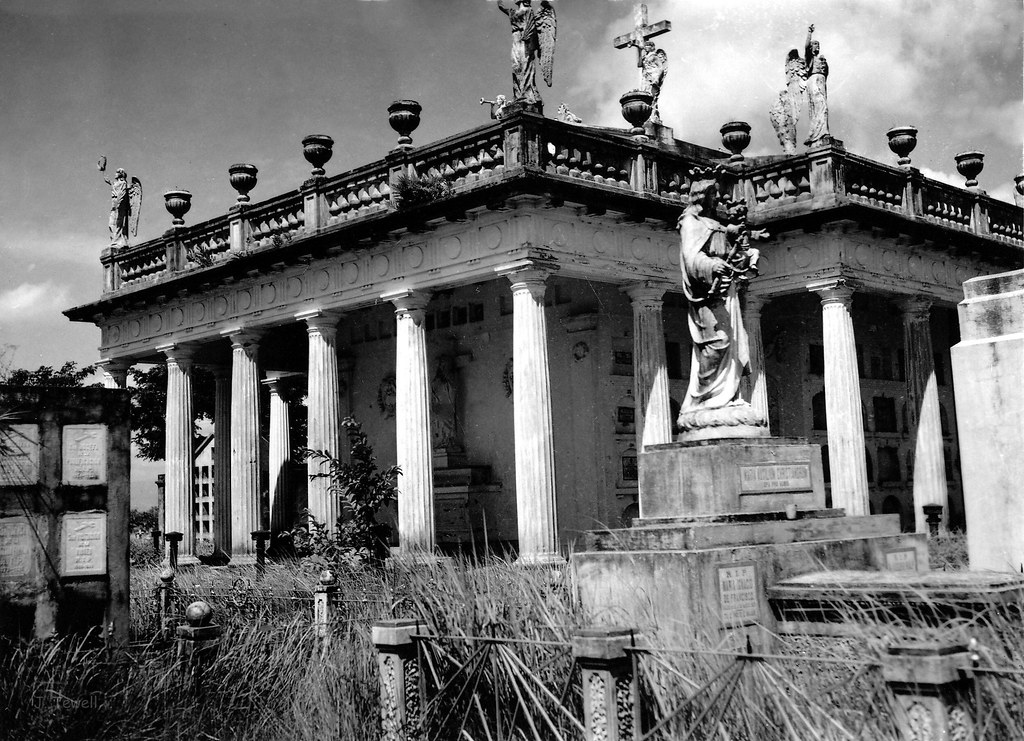 La Loma Cemetery, memorable for its vegetation and semi rural setting that attracts the youth for adventure specially at twilight and even at pitch dark on a moonless night. Every year in the last week of October, Filipinos take a Roman Catholic inspired holiday to remember the dead. Cemeteries all over the country come alive during these days, as relatives of the dead spruce up the graves of their ancestors. |
Japanese Sentry Tower - Camp O'Donnell, Capas, Tarlac 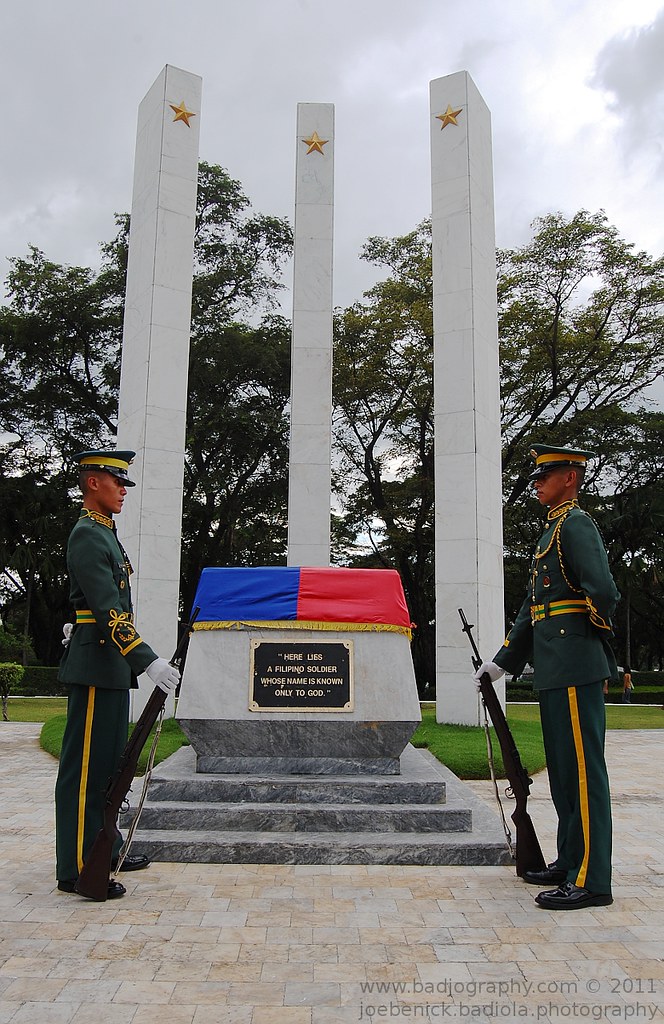 Camp O'Donnel (Capas Tarlac). the American sector of the war memorial. 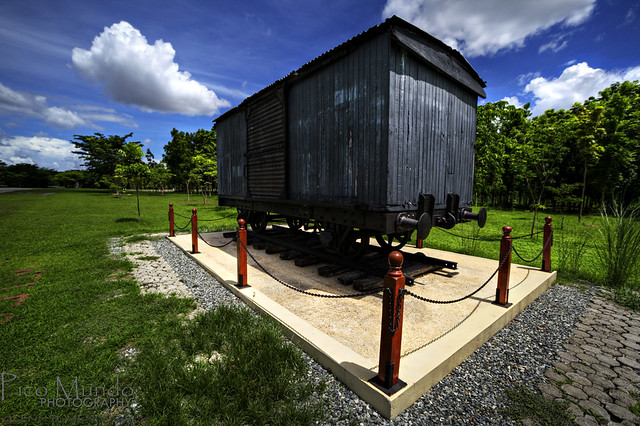 Bataan Death March Box CarIn San Fernando the POW’s where loaded on the trains bound for Capas, Tarlac, The Boxcars normally carried 50 persons, but the Japanese packed them up 100 to 115 Prisoners. At each stop, The Boxcars were open to give the Prisoners fresh Air. The POW’s got off the train at Capas and marched the final kilometer to Camp O” Donnell. | 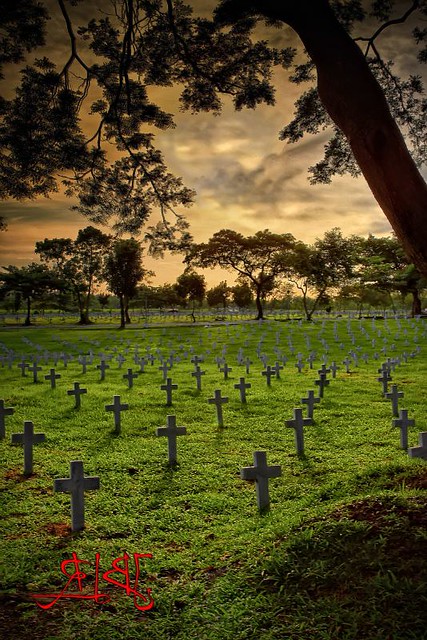 Libingan ng mga bayani. Fort Bonifacio. |
Although La Loma was not a haunted Cemetery, to my belief, there was a time I got stranded after an afternoon play with a classmate. It became a different setting when darkness fell, I felt so alone and just walked fast to get away from the surrounding concrete fence of La Loma. I have been there in 1953 to 1957 and many stories of the ghost of recent burials and internments were circulating around. The image of a young Japanese artillery officer with a close beard haunted the outside graves. Walking in short pants with his samurai sword slung at his side wearing his soldier’s tunic, or seen sitting alone smoking. The description is aptly backed, by the presence of canons, field pieces in the cemetery. He just walks up to visitors and usually asks for a light. Many startled mourners say he will attend a funeral and walk up at the end of services tap you on the shoulder ask for a light. Simply it has been said that, you turn and he's not there. 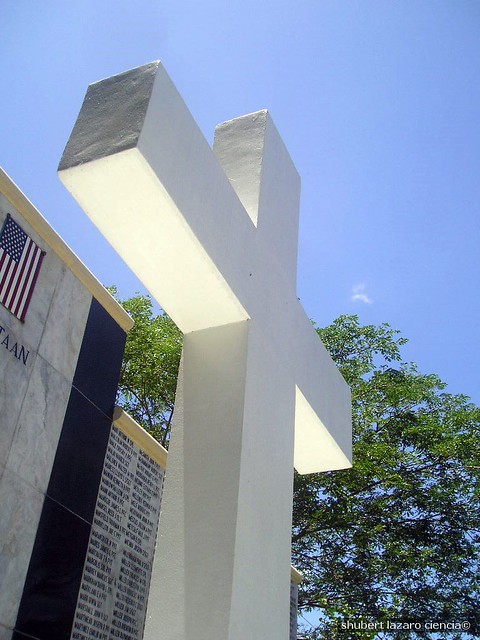 Camp O'Donnel (Capas Tarlac). the American sector of the war memorial.The Cement Cross In wishing to honor our comrades who died so far away from home the battling bastards of Bataan Death March commissioned the construction of this Replica of the “Cement Cross” in the hope that all those who may pass by to view this memorial will remember the many young Americans who gave their lives in defense of their country and of the Philippines. In June of 1942 the Japanese authorities at the American side of the Prisoner of war enclosure at Camp O” Donnell, two kilometers north of this site presented the prisoners with some Cement. The American Prisoners decided to build a Cement Cross to honor the memory of their dead comrades. Completed later that month. The cross remained hidden amidst tall grass until was discovered by returning American Forces in 1945. Left where it originally stood unknown to most and battered by the elements. The cross was again forgotten. Rediscovered by Bataan Veterans visiting the area in 1961. The cross became the historical symbol of the American Prisoner of war enclosure and its dead. When American military presence ended in the Philippines in 1992. The cross was brought to the National Historic Site Andersonville, Georgia, USA. Where it is now kept and displayed. This Replica stand as a reminder of America’s unprepared ness before the outbreak of World War II. | 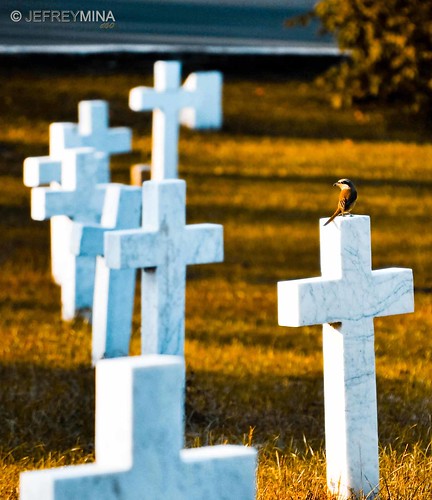 Libingan ng mga BAYANICoast Guard At Port Area Manila left photo, La loma Cemetery next above, Libingan ng mga Bayani (heroes cemetery) Fort Bonifacio close to where we live at the Navy Village, Fort William McKinley then (Fort Bonifacio) It was the final stage of the tragic death march and a concentration camp with an open field which served as the dumping grave site of Filipino and American soldiers who died with debilitating diseases. It has witnessed the endless sufferings of the sick and the neglected only to die, then dropped in mass with three and half feet depth and those who survived the darkest moments of their lives, they narrated with tears clouding their eyes, the traumatic experiences encountered during their detention, as they gasped with depression and sadness and said CAMP O” Donnell, that was. |
For the American people, the fall of the Philippines in 1942 evoked neither the shock of Pearl Harbor nor the defiance born of the Alamo's fight to the last man. Bataan and Corregidor, while not forgotten, were overtaken by the swift currents of other World War II battles, as Americans found new losses to lament and growing victories to celebrate. Survivors of the Philippine campaign quietly languished in squalid prisoner of war camps or, in the case of the few who avoided capture, struck at the Japanese in unpublicized guerrilla raids.
Many of these soldiers felt betrayed by both their government and commander. Their grievance went beyond President Roosevelt's order to General MacArthur to depart the Philippines in March 1942. It was rooted in widely disseminated promises Douglas MacArthur made to his soldiers beginning in the first weeks of the war. In message after message, the charismatic commander bolstered the hopes of his Filipino-American force by conjuring images of a vast armada steaming to relieve the besieged archipelago. Without
revealing details, MacArthur told his warriors: "Help is on the way from the United States. Thousands of troops and hundreds of planes are being dispatched. The exact time of arrival in unknown as they will have to fight their way through." I Buoyed by this hope, the half-starved soldiers fought gallantly and continually frustrated the timetable established by the Japanese army.
35
Japanese forces use flame-throwers while attacking a fortified emplacement on Corregidor Island, in the Philippines in May of 1942. (NARA)
However, the hopes of these brave Americans and Filipinos were misplaced. Even
before his harrowing escape from the Philippines, General MacArthur knew
that relief of the Philippines was all but impossible. Yet, the myth of a large
force bringing desperately needed reinforcements and supplies was perpetuated. As the Bataan perimeter shrank, soldiers kept straining to hear or see the planes and ships promised by their commander. Almost three years would pass before the promise was fulfilled.
Although-the-soldiers stranded in th Philippines cursed-Mac-Arthur for deceiving them, it is clear that the Philippine commander was initially the
victim of lies from his superiors in Washington. The venerable Secretary of
War Henry Stimson, revered Army Chief of Staff George C. Marshall, and the Commander-in-Chief Franklin Roosevelt are sullied by half-truths and false
denials they conveyed to their field commander in the Pacific. Apologists for these World War II heroes argue that false promises made during those dark days of early 1942 were justified. In their view, official words of hope were essential to foster a fighting spirit, not only among the starving and outnumbered soldiers scattered among the Philippine Islands, but on the American home front as well.
There is no denying that assurances of relief raised more of the beleaguered Philippine garrison. But actions taken by American leaders to create false hope were wrong on two counts. First, the decision not to level with the troops proved, in hindsight, to be a prudential error. The practical outcome of the Philippine campaign might have been favorably altered had local commanders been given a truthful assessment of the relief situation. Second and more important, the lies by Roosevelt, Stimson, Marshall, and MacArthur were unethical. Their infidelity was an unconscionable breach of faith that only deepened the final disillusionment of gallant fighters essentially abandoned by the United States.'
Formulation of a Lie
From the disastrous beginning of the Philippine campaign on 8
December 1941, key leaders sensed the hopelessness of the situation. On that day, Henry L. Stimson, Secretary of War and former governor general of the Philippine Islands (1928-1929), noted in his diary: "While MacArthur seems to be putting up a strong defense, he is losing planes very fast and, with the sea cut off by the loss of the Pacific 1 fleet, we should be unable to reinforce
him probably in time to save the islands. However, we have started everything going that we could. ,,'
Stimson's thoughts, recorded on the second day of America's entry into World War II, captured the attitude that would prevail in official Washington from the start of the war until the archipelago fell almost five months later. No one believed relief of the Philippines was possible but most felt there was a moral obligation to try. There were some, however, who felt attempts to relieve MacArthur
were not only futile, but a waste of limited resources. This was certainly the Navy's view. Admiral Thomas C. Hart, commander of the United States
Asiatic Fleet, told General MacArthur that resupply of the Philippines was impossible because of the Japanese blockade and lack of sufficient Allied naval forces. The Joint Board in Washington concurred with Hart and ordered the cancellation of a convoy destined for MacArthur's United States Forces Far East (USAFFE).'
Army Chief of Staff General George C. Marshall felt, as Stimson, that despite limited resources, the men and women fighting in the Philippines could not be abandoned without some effort being undertaken to relieve them. Marshall appealed directly to President Franklin Roosevelt for support. The Commander-in-Chief responded by overruling the Joint Board's decision that would have stopped the relief convoy. Roosevelt also told Secretary of the Navy James Forrestal that the President was "bound to help the Philippines, and the Navy had to do its share in the relief effort.'" Two weeks later in a cheerful New Year's message, President Roosevelt exuded optimism regarding relief of the besieged garrison that many in the islands interpreted as a promise of immediate aid. General Marshall also sought to reassure MacArthur, sending the USAFFE commander encouraging cables detailing weapons and equipment waiting on docks or already en route to the Islands. However, on 3 January 1942, Marshall's War Plans Division issued a frank and pessimistic assessment of the relief situation. The staff officer who developed the report was
Brigadier General Dwight D. Eisenhower, an old Philippine hand who knew MacArthur and the archipelago's defense plan. Eisenhower told the chief of staff that "it will be a long time before major reinforcements can go to the
Philippines, longer than the garrison can hold out." He concluded that a realistic attempt to relieve the Philippine defenders would require so vast a force that it was "entirely unjustifiable" in light of the priority given to the
European Theater.
36
Billows of smoke from burning buildings pour over the wall which encloses Manila's Intramuros district, sometime in 1942. (AP Photo) # 

37
American soldiers line up as they surrender their arms to the Japanese at the naval base of Mariveles on Bataan Peninsula in the Philippines in April of 1942. (AP Photo) # 

38
Japanese soldiers stand guard over American war prisoners just before the start of the "Bataan Death March" in 1942. This photograph was stolen from the Japanese during Japan's three-year occupation. (AP Photo/U.S. Marine Corps) # 

39
American and Filipino prisoners of war captured by the Japanese are shown at the start of the Death March after the surrender of Bataan on April 9, 1942, near Mariveles in the Philippines. Starting from Mariveles on April 10, some 75,000 American and Filipino prisoners of war were force-marched to Camp O'Donnell, a new prison camp 65 miles away. The prisoners, weakened after a three-month siege, were harassed by Japanese troops for days as they marched, the slow or sick killed with bayonets or swords. (AP Photo)
In his diary, Secretary Stimson noted receipt of the "very gloomy study" from the War Plans Division. In Stimson's words, the report encouraged the senior leadership to recognize that "it would be impossible for us to relieve MacArthur and we might as well make up our minds about it." However, either Stimson couldn't make up his mind or he was unwilling to confront MacArthur and others with the growing evidence that supported Eisenhower's conclusion. The Secretary went on to write, "It is a bad kind of paper to be lying around the War Department at this time. Everybody knows the chances are against our getting relief to him [MacArthur] but there is no use in saying so before hand'" (emphasis added). Reflecting Stimson's attitude, Marshall apparently never shared Eisenhower's report with MacArthur nor made its contents public. D. Clayton
James, the respected biographer of Douglas MacArthur, likened Roosevelt's
and Marshall's hopeful words to the false encouragement given by some physicians to dying patients. The President's and Chief of Staff's intent, as
surmised by James, was to brace the Philippine defenders to fight longer than they might have if they were told the truth. According to James, promises
made by Roosevelt and Marshall deceived MacArthur and were "an insult to the garrison's bravery and determination. General MacArthur may have initially been duped into believing the
cheery news from his superiors. But it seems highly unlikely that the savvy MacArthur could have long been deluded as the weeks dragged on and convoys destined for the Philippines were diverted to Australia or Hawaii. Historian Louis Morton, whose book The Fall of the Philippines is recognized as the definitive
work on the topic, notes that USAFFE headquarters was indeed aware that the promised help was unlikely to reach Philippine shores in time. Those who knew the full story told no one. When one American colonel asked a friend on the
USAFFE staff when relief might arrive, the staff officer's eyes "went pokerblank and his teeth bit his lips into a grim thin line." The troops were encouraged to assume help was weeks, perhaps only days away.
MacArthur hammered General Marshall with repeated early messages insisting that the blockade could be broken and demanding that the Navy increase its efforts. Marshall, however, acknowledged on 17 January. 1942 that the only reason the Navy should continue to challenge the Japanese blockade was for "the moral effect occasional small shipments might have on the beleaguered forces."lf MacArthur eventually saw the grim reality of no meaningful relief coming from the United States. By February, his cables to Washington began to raise issues concerning the fate of Philippine President Quezon once the Islands were lost to the Japanese. However, General MacArthur did nothing to alter the original picture he painted for his troops. Thousands of malnourished soldiers, riddled with intestinal disease, clung to the belief that if they could hold out for a short time, they would be saved. There is no evidence that MacArthur and General Jonathan Wainwright had a frank discussion of the relief situation as the latter took charge of the Filipino-American force. The change of command was a hurried affair,
with MacArthur promising Wainwright to "come back as soon as I can with as much as I can." Wainwright's reply, which he came to regret, was, "I'll be here on Bataan ifI'm alive,',Impact on the Soldiers
As word of Douglas MacArthur's escape to Australia spread among American and Filipino troops, morale plummeted. For some, it was a sign that they had been abandoned to face death or capture by the brutal Japanese.
While many experienced this disillusionment, others believed the charismatic MacArthur would return from Australia posthaste leading the relief force.
Indeed, once in Australia, MacArthur's first message was again one of hope. This time he said that the relief of the Philippines was his primary mission. In a pledge that was continuously broadcast and printed on everything from
letterheads to chewing gum wrappers, the general simply stated, "I made it through and I shall return. There is ample evidence that soldiers placed great stock in MacArthur's renewed pledge from Australia. When "Skinny" Wainwright made the fateful decision to surrender the entire Philippine command in May 1942,
There is ample evidence that soldiers placed great stock in MacArthur's renewed pledge from Australia. When "Skinny" Wainwright made the fateful decision to surrender the entire Philippine command in May 1942, hundreds of Americans refused to obey the order. One often-cited reason for this disobedience was the belief that General MacArthur would be back to disregarded surrender orders and took their chances in the jungles, waiting for MacArthur's supposed imminent return." Even Major General William F. Sharp, who refused to surrender his Visayan-Mindanao Force for a number of days after Wainwright's capitulation, appeared to believe MacArthur might return at any time. Sharp's staff chaplain wrote after the war that the general cabled MacArthur for guidance
regarding Wainwright's order to surrender. MacArthur's reply appears to have been a surprise to Sharp, as revealed in this published account:
"We sent out your message [to General MacArthur], Sir, and we have just decoded a message from down south [Australia]."
All eyes were on General Sharp as he read the message. There was no expression on his face. "Gentlemen, this is MacArthur's final message: 'Expect no immediate aid! ... This was a hard blow, as rumors flew thick and fast that our fleet was on its way to save the Philippines. None of us had doubted this and we had expected to hear soon the skies thunderous with many planes."
Not surprisingly, disillusioned soldiers directed their resentment and animus toward MacArthur. The depth of this enmity was apparent in Brigadier General William Brougher's after-action report written in a Japanese POW
camp. Brougher, a division commander on Bataan, concluded his report in
extraordinarily condemnatory language: Who took responsibility for saying that some other possibility [relief of the Philippines] was in prospect? And who ever did, was he [MacArthur] not an
arch-deceiver, traitor, and criminal rather than a great soldier? ... A foul trick of deception has been played on a large group of Americans by a Commanderin-Chief and small staff who are now eating steak and eggs in Australia. God damn them!
Although 47 years have passed since the faU of the Philippines, some survivors of that ordeal express undiminished bitterness at being deceived by the promise of imminent relief from the United States. One veteran recently wrote, We all knew when General MacArthur ... was ordered by President Roosevelt to desert us, he left General Skinny Wainwright holding the bag. We knew we
would be killed or captured. As a kid in school, we were taught the captain was the last man to leave the ship. He said, "I shall return." Three years later, by the time he returned, two thousand of his men ... had died.
As one former soldier wrote, "After fighting in the jungle for five months without any support whatsoever except lip service from our US government, I felt our government had deserted me.""
Regardless of how the blame is spread for this prevarication, the fact is that Roosevelt, Stimson, Marshall, and MacArthur all refused to level with the troops. Failing to inform the soldiers that substantial relief of the Philippines was several months or even years away may be described as an exaggeration or half-truth rather than a lie. Whatever label given to this false promise, it was a breech of ethical standards. Soldiers in the Philippines fought gallantly and held out longer than expected, but at the cost of distrust, bitterness, and resentment toward their leaders and government. Professional Ethics, Military Necessity, and Exceptions to the Rule. The implicit question posed by this episode-when is lying to the troops justified?-is likely to elicit an immediate and resounding "Never!"
from most military officers. As retired Major General Clay Buckingham wrote in an essay on ethics, the oath of a professional officer should be "to tell the truth, the whole truth, and nothing but the truth.,,20 Half-truths or deceptions do not fall within the military's concept of honor and integrity. Not surprisingly, a plethora of books and articles on military ethics echo this view, using vignettes or case studies to illustrate the critical nature of honesty in the military.
While the US Army has never published a formal code of ethics, Field Manual 1 00-1, The Army, does devote a Chapter to the professional Army ethic and individual values. Among the key values listed is candor, described as "honesty and fidelity to the truth .... Soldiers must at all times demand honesty and candor from themselves and from their fellow soldiers.""
The values espoused in FM 100-1 are a distillation of ethical standards and moral beliefs that have been operative in the US Army from its conception. Lying and deception as devices to motivate soldiers to accomplish the mission were ethically wrong in 1942 just as they are today. True, anyone
can concoct a hypothetical situation where a lie or half-truth may be used to save an innocent life. But a moral dilemma that offers lying as the only means to preserve life is extremely rare. Building morale on a deception or motivatiing soldiers with a lie remains unethical. Did our towering leaders of World War II-Roosevelt, Stimson, Marshall, MacArthur-set a course knowing their acts were unethical or, as more likely, did they hold to some other ethical precept they felt to be more compelling than honesty and candor? In questions of morality and ethics, even the most sacred values are challenged when they collide with other bedrock principles. The promise of help to the Philippines is a case in point. America's
war planners in Washington and MacArthur in the Pacific may have viewed their deception to the troops as a "military necessity." Simply put, military necessity is action that is necessary in the attainment of the just and moral end for which war is fought. Even military necessity, however, does not excuse all steps taken in the name of a "just war." There must be some sense of proportion. Philosopher Michael Walzer of the Princeton Institute for Advanced Studies points out that we must weigh the damage or injury done to individuals and mankind against the contribution a particular action makes to the end of victory."
To appreciate this argument it is important to recall the military and political situation in the Philippines. In the first months of America's entry
into World War II, victory over Japan was far from certain. For Marshall and Stimson, and particularly for the nation's political leader, Franklin Roosevelt, the battle for the Philippines was a symbol of America's resolve to stay in the
fight despite repeated setbacks in the Pacific. It was feared that early capitulation or mass desertions in the Philippines would have great moral and political significance for the nation. This can be inferred from the revealing and startling passage Secretary Stimson wrote in his diary on the eve of Bataan's surrender:
[It has been suggested] that we should not order a fight to the bitter end [in the Philippines] because that would mean the Japanese would massacre everyone there. McCloy, Eisenhower, and I in thinking it over agreed that ... even if such
a bitter end had to be, it would be probably better for the cause of the country in the end than would surrender. Obviously, the War Department was willing to go to great lengths to keep Wainwright and his troops in the fight. There was apparently the presumption that final victory over Japan would be hastened and morale at home bolstered by frustrating the enemy's timetable in the Philippines. However, the United States lacked sufficient war materiel to ship to the islands and had no means to pierce the blockade. Roosevelt, Stimson, and Marshall therefore chose to send the brave defenders words of hope regarding relief efforts in order to encourage them to hold on as long as possible.
One can speculate endlessly on what might have happened had the soldiers been told from the outset that they would have to fight without expectation of relief. Perhaps little would have changed. Even before America
was catapulted into the war by the attack on Pearl Harbor, the Japanese army had an established record of atrocities and disregard for human life. This was verified in the first weeks of the Philippine campaign when soldiers found
evidence of prisoners being tortured and executed by their Japanese captors. In short, Americans and Filipinos had little incentive to surrender. With departure of the bulk of the US Asiatic Fleet in December 1941, there was no
means of mass evacuation or escape from the various islands. The soldiers had every reason to fight on toward an uncertain end. However, had the truth been served, the combined American-Filipino force might have succeeded in frustrating Japanese plans to a far greater
degree. MacArthur and Wainwright could have done more to plan for and establish a guerrilla organization if they had realized earlier in the campaign that adequate resupply and assistance would not be forthcoming. Final conquest of the archipelago might have been delayed by several more months by abandoning the stubborn defense of Bataan and infiltrating guerrilla teams
north into the Luzon hills. One Japanese general noted that "a well-planned guerrilla defense should have prolonged the warfare after the conquest [of the Philippines] and should have made [MacArthur's] comeback much easier.""
Perhaps this was more than could have been expected from the malnourished soldiers who were virtually all ravaged by disease. But by hanging onto the false hope of relief convoys steaming to the rescue, there
was no thought given to abandoning the Bataan Peninsula with its key city of
Manila and deep harbor at Subic Bay. Only a handful of soldiers ever made it to northern Luzon, where cool mountain hideaways offered an excellent base from which to launch guerrilla operations and a reprieve from Bataan's
malaria-ridden jungles.
On a more basic level was the effect MacArthur's promises had on individual soldiers. Had the troops on Bataan been told the truth and dealt with in a forthright manner, they might have been better prepared psychologically for the fate that surely awaited them. Perhaps some who perished during brutal Japanese captivity would have survived. We will never know, but the possibility alone makes this a point worthy of consideration by today's leaders.
Conclusion: A Lost Opportunity
and An Inexcusable Breach of Integrity Exactly how much each of the key players knew about the Philippine relief effort as the first weeks and months of the war unfolded is unclear. However, there is no doubt that early in the war, Roosevelt, Stimson, and Marshall were not candid with MacArthur about the impossibility of supplying adequate relief for the Philippines. MacArthur's promise of massive convoys steaming toward the Philippines may have initially been a reflection of his faith in Washington to deliver on promises of immediate aid. However, at some point, MacArthur clearly came to know his repeated pledge of relief was years away from fulfillment. Despite this knowledge, he continued to talk
of massive relief and did nothing to quash the rampant rumors of resupply and support which he had fostered.
One can hypothesize about how pure the motives were for each actor. Few question that those in Washington felt hopeless and distressed at being unable to give the Philippines the assistance that was so desperately needed. MacArthur's cables to Washington made clear his own frustration at being denied priority over war plans for Europe when his men were fighting for their very lives. However, in the trenches of Bataan and the bunkers on Corregidor, the result was the same. Soldiers built their hopes on a phantom army that failed to materialize before the Japanese overwhelmed them.
Ethically, the claim of military necessity is a transparent attempt to justify unfaithfulness to the basic moral obligation of honesty and candor. One must sadly conclude that four distinguished figures of World War II, President Franklin Roosevelt, Secretary of War Henry Stimson, General George Marshall, and General Douglas MacArthur, stained their honor by perpetuating a lie. It should come as no surprise that the military's civilian masters in Washington
were willing to expend soldiers' lives without concern for the truth. Throughout our country's brief history, politicians have shown a limited regard for candor and honesty in both peace and war. But it is hoped that the commander in the field will always be truthful. His honor as a soldier must be absolute. Taking the high road and being honest with the troops would probably not have changed the final outcome in the Philippines. The success of the Japanese invasion was inevitable. Honesty and candor might have made a difference after the fall of the Philippines as soldiers stole away into the jungle or marched toward wretched prisoner of war camps. Had these soldiers not
been deceived, they would have at least been sustained by faith in their leaders, trust in their country, and belief in the military ethic. As it was, these
moral anchors were undermined when it became clear that the promises their leaders made regarding relief of the Philippines were lies. Perhaps this loss of the moral underpinning of an army was as regrettable as the military loss of the Philippine Islands themselves.
40
American prisoners of war carry their wounded and sick during the Bataan Death March in April of 1942. This photo was taken from the Japanese during their three year occupation of the Philippines. (AP Photo/U.S. Army)
The defense of the Philippines cannot be understood in terms of conventional military strategy. In those terms it was one incomprehensible blunder after another, done with due deliberation and afterward profusely rewarded. Just as Clauswitz said war is politics by other means, the sacrifice of the Philippines can only be understood in the larger political context. Analysis of local decisions by MacArthur, miss the point that FDR was actually calling the shots. His motivations, not MacArthur's are at issue. The sacrifice of the 31,095 Americans and 80 thousand Filipino troops with 26 thousand refugees on Bataan is a separate issue from the sacrifice of the Army Air Corps at Clark and Iba.
Solemnly promising the nation his utmost effort to keep the country neutral, U.S. President Franklin D. Roosevelt is shown as he addressed the nation by radio from the White House in Washington, Sept. 3, 1939. In the years leading up to the war, the U.S. Congress passed several Neutrality Acts, pledging to stay (officially) out of the conflict. (AP Photo)
The bombers were sacrificed, not only to facilitate the loss of the Philippines, but more immediately to sucker Hitler into declaring war on the United States and events in the Philippines are analogous to Pearl Harbor which happened the same day. However, Hitler did declare war on December 11th and therefore obviously the sacrifice of Bataan proper springs from other motives. To understand Roosevelt's strategy we have to ask a very basic question:Cui bono? "Who benefits?" Who benefited from Japan's temporary ascendancy and the war dragging on? It was obvious that when the Japanese Empire collapsed that there would be a power vacuum in Asia. The ultimate question of the Pacific War was who would fill that vacuum. Who would take China? Roosevelt wanted Russia to fill the vacuum (cf. his actions at Yalta and How the Far East Was Lost, Dr. Anthony Kubek, 1963) and therefore had to prolong the war so the Soviet Union could pick up the pieces. Because the Soviet Union had its hands full fighting Germany and could not dominate Asia until the war in Europe was under control, delay in the defeat of Japan was necessary. Bataan was a pawn in a larger game. The Battling Bastards of Bataan never understood enough to ask the critical question - "who was their real enemy?" It was Franklin Roosevelt.
The orders to fight on all beaches and not supply Bataan were nothing less than the deliberate sacrifice of 31,095 Americans.
41
These prisoners were photographed along the Bataan Death March in April of 1942. They have their hands tied behind their backs. The estimates of the number of deaths that occurred along the march vary quite a bit, but some 5,000 to 10,000 Filipino and 600 to 650 American prisoners of war died before they could reach Camp O'Donnell. Thousands more would die in poor conditions at the camp in the following weeks. (NARA)


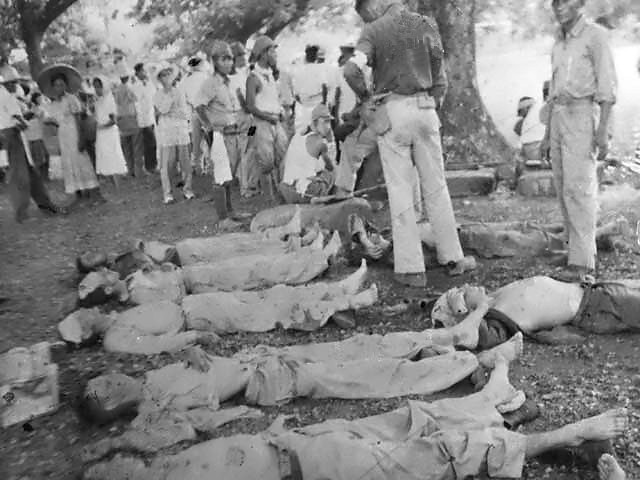




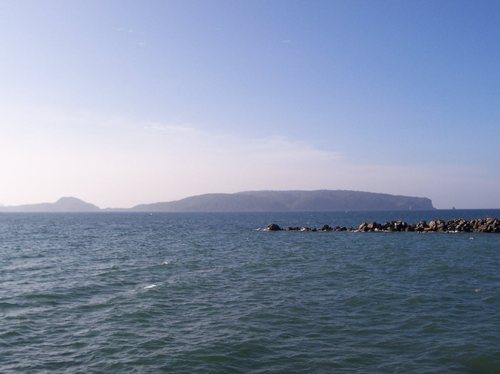
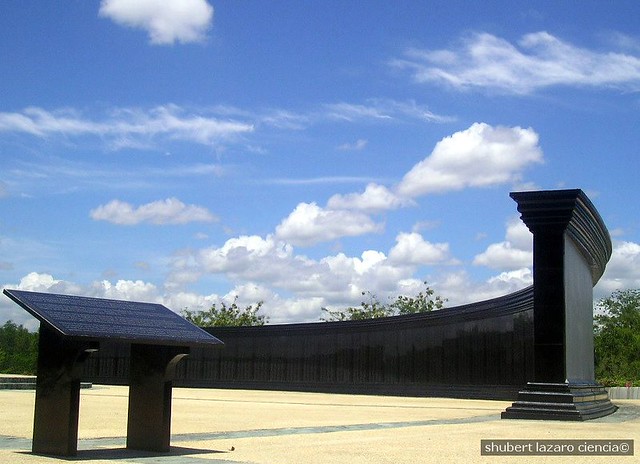

No comments:
Post a Comment